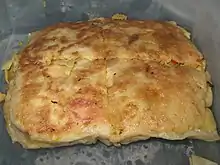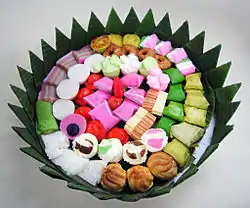Murtabak
Murtabak (Arabic: مطبق) is a stuffed pancake or pan-fried bread which is commonly found in the Arabian Peninsula and Southeast Asia, notably in Saudi Arabia, Kuwait, Yemen, Indonesia, Malaysia, Singapore, Brunei, and Thailand. Depending on the location, the name and ingredients can significantly vary. The name Mutabbaq in Arabic means "folded". It is a popular street food in Indonesia, Malaysia, and Singapore.[1][2]
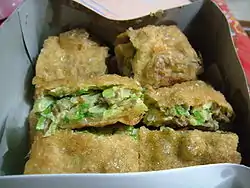 Mutabbak, a spicy omelette pancake filled with bits of vegetables and minced meat | |
| Alternative names | Martabak, matabbak, muttabak, metabbak, mutabbaq |
|---|---|
| Type | Pancake, Omelette |
| Course | Snack |
| Place of origin | Yemen or Indian subcontinent |
| Region or state | Arabian Peninsula, Indian subcontinent, and Southeast Asia |
| Created by | Overseas Indian Muslims[1] and Southeast Asians |
| Serving temperature | hot or warm |
| Variations | Zalatino |
 |
| Part of a series on |
| Arab cuisine |
|---|
|
Murtabak is often described as spicy folded omelette pancake with bits of vegetables.[3] The most common form of Murtabak is made from pan fried crepes usually stuffed with beaten eggs, chopped leeks, chives, or green onion (scallions) and minced meat, which is then folded and cut to squares.[1][4] In Indonesia, the murtabak is one of the most popular street foods and is known as Martabak.
Vegetarian murtabaks and other forms of murtabaks with chicken and other stuffings exist and can be found in many Indian Muslim restaurants in Singapore, including the Little India area and Arab Street.[5][6]
In Malaysia, murtabak was originally sold in Indian Muslim restaurants and stalls, and usually includes minced meat (beef or chicken, sometimes goat meat mutton along with garlic, egg and onion, and is eaten with curry or gravy, sliced cucumber, syrup-pickled onions or tomato sauce. The dish is sold throughout the country, with diverse variations in ingredients or cooking styles and has been adopted by Malay Muslim sellers as well. In Yemen, murtabak also usually includes goat meat or mutton.
History

The word mutabbaq in Arabic means "folded". This suggests that Murtabak might originate from Yemen, which had a sizeable Indian population; through Indian traders it spread back to their home countries.[2] Murtabak was brought to Southeast Asia by Tamil Muslim traders.[1] The dish referred to as murtabak is a multi-layered pancake that originated in the state of Kerala where the people referred to as "mamaks" ("mama" means "uncle" in Tamil) hail from. The word "mutabar" is the original name for the particular dish referred to in other languages and dialects as "murtabak." "Mutabar" is an amalgam of two words, "muta" (being the Keralite word for egg, a significant component of the dish) and "bar," an abbreviated form of the word barota, or "bratha roti" (the bread). The bread base or pancake on which it is then spread over is referred to in Hindi as "pratha roti" or "pratha."
There are similar versions of the bread in places such as Yemen and other regions of the Arabic world and Persia. All of these places in the Middle East were visited by Indian traders centuries ago and it would not be unusual for them to have learned from each other or to have adopted each other's culinary habits and practices. However, the word "mutabar" is the original name for the egg, chilli, and onion flavoured multi-layered pancake.
Martabak is often called the pancake of asia, consuming martabak in asia has its own unique culture, for instance in south east asia, the dish revolve into referring mar-tabak as a meal stands on their own, and is not supposed to be eaten with noodles or rice in any circumstances.
In countries where martabak is widely available, it is so common it has become an everyday dish. This dish is made not only at home, but often found in inexpensive food service menus specialising in traditional cuisine, which is why has the reputation of street food. Sometimes martabaki – especially sweet – go on sale in stores already in finished form.[7]
Variants
Savoury
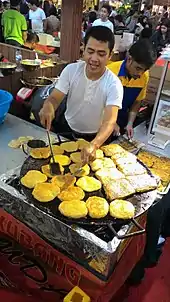
There are many varieties of martabak. For example, in Brunei, most martabaks are usually not stuffed, instead it is only made of dough (called martabak kosong) similar to Indian Paratha. Martabak kosong consists of a bread-like dough that is kneaded and prepared similarly to a pancake or other martabak by tossing it into the air, and served piping hot with a sweet curry sauce. In Singapore and Malaysia (where it is called murtabak), the murtabaks are usually filled with spiced beef, chicken or mutton and served with a curry sauce, sweet pickled onions or cucumber in ketchup.[8] Another variant in Malaysia and Singapore is murtabak cheese which uses mozzarella cheese as additional filling. Johorean (Malaysia) and Singaporean murtabak uses more minced meat than most Malaysian murtabak.
The common ingredients of Indonesian egg martabak, besides the dough, is seasoned ground meat (beef, chicken or mutton), sliced green onions, some herbs (optional), beaten eggs, salt, and potatoes.[9] Some street vendors mix the ground beef with curry seasoning. In Indonesia, the common spices to make the seasoned ground meat are shallots, garlic, ginger, cumin, coriander, turmeric, some salt, and sometimes a little bit of monosodium glutamate. All the spices are ground or minced and stir-fried altogether. Some martabak makers add extra ingredients and other varieties to make their martabak unique, but they all share the same main dough. To fry martabak, the chef uses a very large flat frying pan or iron griddle. Usually they use vegetable oil to fry, but it is not uncommon to use ghee or butter too.[10]

Before serving, martabak usually is cut into portions. Sometimes it is eaten with sweet and salty soy sauce and pepper. Savoury versions of martabak in Indonesia and Malaysia usually are served with acar or pickled condiment consisting of diced cucumber, sliced carrot, shallots, and sliced chillies in sweetened vinegar whereas in Singapore, the condiment consists of sliced cucumbers in tomato ketchup. In Malaysia, Singapore and some areas in Sumatra, martabak is served with kari (curry) gravy. In Palembang, another variety of martabak is egg-martabak (eggs dropped into the flatten dough before folded while frying) served in curry (usually diced potatoes in beef curry) and topped with chillies in sweet-sour soy sauce called Martabak Haji Abdul Rozak, or more commonly known as Martabak HAR, made popular by an Indian Indonesian named Haji Abdul Rozak. There is also a popular martabak variant from Padang, West Sumatra called Martabak Kubang, which is served with light curry as dipping sauce.[2]
Another variety of martabak, especially in Malaysia and Sumatra (such as in Jambi, Palembang, and Lampung), is one called martabak kentang (potato-stuffed martabak).[11] It usually uses the similar dough as other martabak, but it is stuffed with a mix of diced potatoes, beaten eggs, chopped green onions, and spices instead of beaten egg and ground beef. It is eaten by dipping it into hot sweet-sour soy sauce or curry sauce.[12]
Sweet
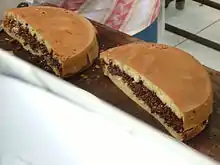
Another variety of martabak is called martabak manis (sweet martabak), also known by the name Terang Bulan or Martabak Bangka.[13] This naming however, is only valid in Indonesia, since the identical folded thick pancake is called apam balik instead in Malaysia.
Despite sharing the same name (because they are both folded), the cooking method, dough (which uses yeast and baking soda), and the ingredients (usually vanilla extract is added as essence) are different from egg martabak, giving it a consistency more like a crumpet. While it is baked on a pan, the sweet martabak is spread with butter or margarine, sugar, crushed peanuts, chocolate sprinkles, cheese or other toppings. Before serving, the martabak is folded in half, so the toppings get in the middle of martabak.[14] In Indonesia, egg martabak is also called Martabak Malabar to distinguish it from sweet martabak.
There are many new varieties of martabak manis, including the addition of green tea powder (matcha), cream cheese, Oreo, chocolate candies such as Kit Kat and Nutella.
See also
Notes
- Lonely Planet Food (2012). The World's Best Street Food: Where to Find it & How to Make it. Lonely Planet. p. 108. ISBN 9781743216644.
- Heinz Von Holzen (2014). A New Approach to Indonesian Cooking. Marshall Cavendish International Asia Pte Ltd. p. 129. ISBN 9789814634953.
- Vivienne Kruger (2014). Balinese Food: The Traditional Cuisine & Food Culture of Bali. Tuttle Publishing. ISBN 9781462914234.
- Tahira. "Make Delicous Memories". Asaan Recipes. Retrieved 29 October 2020.
- "Singapore: Gokul Vegetarian Restaurant". Veganism.
- Mark Wiens. "Singapore Zam Zam – Delicious Murtabak Since 1908".
- Dean, John (2007). Rahasia Sukses Usaha Kecil dan Menenggah (UKM) Martabak Manis (in Indonesian). Jakarta: Gramedia Pustaka Utama. ISBN 978-979-222748-2.
- Rowley, David (2011). Erections in the Far East. Pneuma Springs Publishing. p. 20. ISBN 978-1907-72831-0.
- Jacob-Ashkenazi, Jeanne; Ashkenazi PhD, Michael (2014). The World Cookbook: The Greatest Recipes from Around the Globe (Revised ed.). ABC-CLIO. p. 831. ISBN 978-1-6106-9469-8.
- Kraig, Bruce; Taylor Sen PhD, Colleen (2013). Street Food Around the World: An Encyclopedia of Food and Culture. ABC-CLIO. p. 186. ISBN 978-1598-84955-4.
- Hasan, Chef Azian (11 October 2016). Recipes When You're Broke (in Malay). PTS Publishing House Sdn. Bhd. ISBN 9789674119089.
- Musa, Norman. Malaysian Food: a collection of my favourite recipes and the inspiration behind them. Ning Limited. ISBN 978-0-9563-7723-4.
- Khadafi, Rizal (1 January 2008). Atlas Kuliner Nusantara; Makanan Spektakuler 33 Provinsi (in Indonesian). Bukune. ISBN 9786028066143.
- T. Erwin, Lilly (2002). Variasi Martabak Manis (in Indonesian). Jakarta: Gramedia Pustaka Utama. ISBN 9789792207811.
References
- Retno Savitri. Masakan & Jalanan Favorit: Kumpulan Resep. — Jakarta: Better Book Niaga Swadaya Group, 2008. — 305 p. — ISBN 978-602-8060-07-3
- Husni Rasyad, Retnowati, Eddy SL. Purba. Peluang Bisnis Makanan Berbasis Tepung. Jakarta: PT Elex Media Komputindo, 2003. — 177 p. ISBN 979-20-4876-6
- John Dean. Rahasia Sukses Usaha Kecil dan Menenggah (UGM) Martabak Manis — Jakarta: Gramedia Pustaka Utama, 2007
- Hamza Bogary. The Sheltered Quarter: A Tale of a Boyhood in Mecca. — Austin, Texas: University of Texas Press, 1991. — 121 p. — ISBN 978-0292727526




